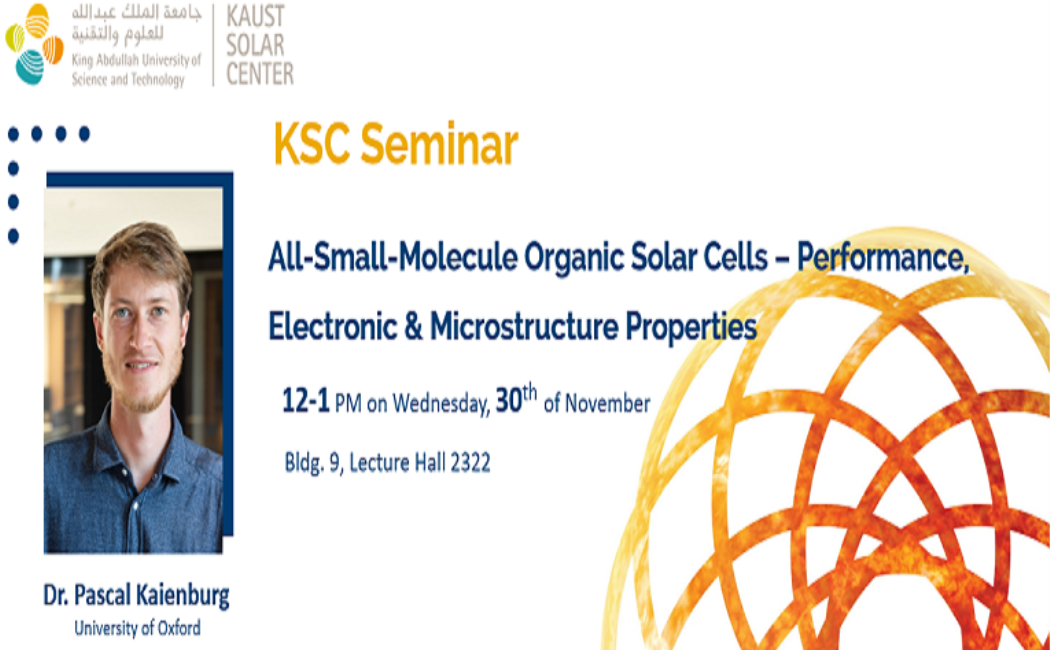Welcome to KSC
Latest News
23 August, 2023
KAUST New Strategy
Here you can get more information about the Kaust New Strategy.
13 April, 2023
KAUST team sets world record for tandem solar cell efficiency
Researchers in the King Abdullah University of Science and Technology (KAUST) Solar Center have developed the world’s most efficient silicon/perovskite tandem solar cell at 33.2% efficiency.
21 November, 2022
Professor Qiaoqiang Gan elected Fellow of Optica
Qiaoqiang Gan, KAUST professor of material science engineering, was recently elected as an Optica Fellow (formerly OSA).

KSC Seminar with Dr. Pascal Kaienburg
KSC Seminar: All-Small-Molecule Organic Solar Cells – Performance, Electronic & Microstructure Properties
About the Speaker:
Pascal Kaienburg
Pascal is an early-career researcher in the Department of Physics at the University of Oxford, UK, where he works closely with the group of Moritz Riede. He holds an independent EPSRC postdoctoral and David Clarke fellowship. Pascal currently investigates All-Small-Molecule Organic Solar Cells, processed from solution or in vacuum. Working with industrially relevant technologies, he is interested in the interplay between microstructure, phase behaviour, optoelectronic properties, and device performance in organic solar cells.
Pascal obtained his Master’s in Physics from RWTH Aachen University, Germany. He then conducted his PhD research with Thomas Kirchartz at the Research Centre Jülich, where he focused on device simulations of various aspects of thin-film-solar cells, as well as the characterization and fabrication of Antimony Sulfide solar cells from solution.
Abstract of the Talk:
Organic photovoltaics (OPV) based exclusively on small molecules have distinct advantages over polymer-based OPV for commercial applications. Unlike polymers, small molecules have a defined molecular weight and can be purified easily, resulting in a simpler, more reproducible synthesis with controlled quality. Solution-processed All-small-molecule (ASM) OPV has reached 17% power conversion efficiency, and ASM-OPV fabricated via vacuum thermal evaporation (VTE) are leading OPV commercialization. However, ASM-OPV remain less investigated than polymer-based OPV in terms of their optoelectronic and microstructure properties.
First, by means of device simulations, I will discuss how semiconducting properties of an absorber material influence solar cell performance in a quantitative fashion. We find that absorption coefficient, charge carrier mobility and recombination coefficient are equally important for solar cell efficiency. This provides simple figures of merit for new materials as well as a target for molecule synthesis and material characterization.
Then, we perform extensive optoelectronic characterization on representative ASM-OPV deposited from solution and in vacuum to quantify absorption, voltage losses and charge transport – probed via ellipsometry, sensitive EQE and CELIV, respectively. Example systems include VTE DCV5T-Me:C60 and DTDCPB:C60. We find that certain VTE ASM-OPV achieve strong absorption, decent charge carrier mobility, or voltage losses matching corresponding polymer-based OPV but no VTE blend combines all these favourable properties. In an outlook, I will present ongoing work on the blend microstructure in terms of phase separation. Interdiffusion experiments offer a thermodynamic perspective while the actual phase separation is probed via soft X-rays. This will cover evaporated blends as well as solution-processed all-small-molecule blends such as BTR-Cl:Y6. This talk gives an overview over prospects and challenges of All-Small-Molecule organic solar cells and the resulting open research questions.
Schedule
Wednesday, November 30, 2022, from 12:00 PM – 1:00 PM
Location
Building 9, Lecture Hall 2322
For more information, please email: ksc@kaust.edu.sa